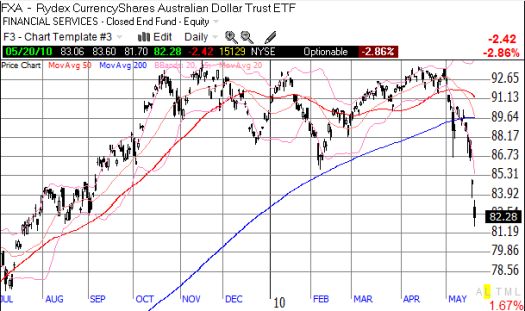The Australian dollar has been my single source of greatest pain during this market correction. I have long favored the Australian dollar as a play against the U.S. dollar. Even as the U.S. dollar index has rallied over 10% since hitting 16-month lows in November/December, the Australian dollar remained flat during most of that time (note that the Australian dollar is not included in the dollar index).
In the past two days, the Australian dollar violently broke down from its trading range. It has lost almost 10% against the U.S. dollar in just five days – a tremendous move. The chart of the ETF shows that the currency has suddenly collapsed all the way to lows from last August.

*Chart created using TeleChart:

Ordinarily, I would consider such a drop to be a golden buying opportunity, but these are no ordinary conditions. The commodity complex is crumbling as deflation fears soar once again. I understand that such fears can last much longer than I can ever expect. Moreover, the bearish case for stocks that I have outlined over the past several weeks, implies that the U.S. dollar (and Japanese yen) should sustain their strength for some time and growing problems with the “China story” will continue to weigh on anyone dependent on Chinese largess, like the Australians.
Note that for now, the Reserve Bank of Australia (RBA) generally expects earlier stimulative policies to continue to bolster commodities over the longer-term horizon:
“…the stimulatory effects of the resources boom would be building over the year ahead. Members were conscious of the need for this not to result in a material worsening in the medium-term outlook for inflation. This was weighed against the case that could be made for a pause in the process of normalising interest rates owing to the uncertainty in the euro area. On balance, members judged it to be prudent to undertake some further monetary tightening at this meeting. They noted that, if lenders responded as expected to another rise in the cash rate, interest rates faced by most borrowers would then be at around their average levels over the past decade.” (from Minutes of the Monetary Policy Meeting of the Reserve Bank Board, May 4, 2010)
Ultimately, I anticipate that central banks will confront fears of deflation and/or an actual resumption in economic stagnation with even more printing of paper money – with America leading the way. So, over a longer horizon, I have to continue to favor the Australian dollar over the U.S. dollar. These current levels are likely ideal for playing a short-term bounce , but I can easily see the Australian dollar hitting even lower levels after such a bounce loses its steam. I am not sure yet at what point I add to my long-term position, but now does not appear to be that time. (In the meantime, I am more actively trading AUD/USD and GBP/AUD in forex after getting stopped out of Aussie-bullish positions).
Be careful out there!
Full disclosure: long FXA
